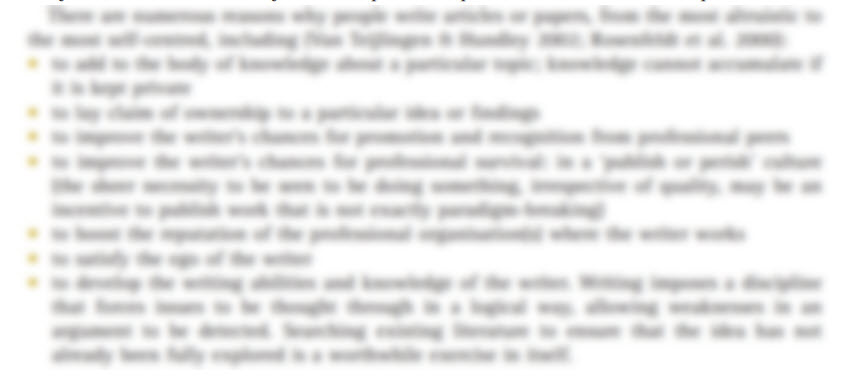Choosing the right journal is a crucial step in getting your paper successfully published. Where you publish is also important when establishing your career as a researcher and may improve your ability to attract funding. Choosing the right journal is an important part of the planning process when drafting your paper. Ideally, you should decide what journal you will submit to before you start writing, as each journal will have unique requirements and target different audiences.
1. Create a draft list of journal titles that appear suitable at first glance
Based upon your knowledge, advice from colleagues and word-of-mouth, create a draft list of 20-40 journal titles that appear suitable at first glance. You can also use search engines (e.g. ‘marine biology journals’) and journal finder tools and databases (e.g. Scopus). Also look in the reference lists of the papers that you read.
2. Define your publishing objectives and preferred journal's attributes
In addition to simply wanting your paper to be published, you need to have clear objectives about how and where you want your work published. Determining how different journals can meet your objectives will help you decide what journal to choose. Having clear publishing objectives is also important if you are co-authoring a document.
The following is a list of journal attributes that should be considered when working out your objectives:
Does the journal meet your institutions’ or funding body’s guidelines?
Different universities, departments and other organisation will have guidelines and criteria for journal selection. For example, the Excellence in Research for Australia (ERA) is Australia’s national research evaluation framework and stipulate that research output must satisfy certain criteria, including the type of journal.
Does your study subject and publication type meet the journal’s Aim and Scope?
The journal’s Aims and Scope gives an overview of what subject or topics they publish; for example, the Journal of Cell Science states it is “…committed to publishing the full range of topics in cell biology.” The journal’s Aims and Scope also often outlines what types of papers they publish and their peer review policy. Other crucial information (e.g. page limits) will also be found in the Instructions to Authors.
Consider the journal’s readership and target audience
Does the journal’s readership and target audience match the target audience of your paper? For example, if you have a multi-disciplinary project or topic, you might want to choose a multi-disciplinary journal (for example PLOS One).
What is the journals’ Impact Factor?
The impact factor of a journal is a high profile and controversial measure used to rank, evaluate and compare journals and is published in the Journal Citation Reports (JCR) by Clarivate Analytics. Clarivate Analytics defines impact factor as a “a measure of the frequency with which the “average article” in a journal has been cited in a particular year or period. The annual JCR impact factor is a ratio between citations and recent citable items published.”
Is the journal indexed in well-known databases?
Indexing refers to whether a journal is listed in databases and search engines well known within your discipline. If your journal of choice is indexed by a well-known database (for example Web of Science or PubMed), once your paper is published, both your journal and paper will be found within this database. Some databases only include abstracts, some include the entire paper and the citation index. Read more about indexing here.
Do you agree with the journals peer-review policy?
This information should be listed on their website, often under the Aims and Scope section. For example, the journal Trials uses an open review system.
How long does the journal take to publish your paper?
The time taken to review your document and notify you of acceptance or rejection will vary between journals and can be a source of frustration. Knowledge of the publishing process will help you determine when to expect to receive a response. ‘The production process’ by Wiley clearly outlines the steps taken with their journals. Some journals take longer to release your paper after acceptance than others. The Journal of Medical Internet Research estimates it takes them from 4-6 weeks.
Where do your peers publish?
Your paper needs to be seen by your peers if it has any chance of being read and cited. Therefore, it should be published in the journals that they are likely to read. For example, if I were an active ecological researcher in Australia, I would consider publishing in Austral Ecology as it is well known and highly regarded.
Check the journal’s reputation
Only publish your paper in reputable journals. Early-career researchers might not be fully aware of fake or predatory journals that pretend to have a good reputation, accept your paper with minimal or no review and then charge you for submission. If you send a paper to a predatory journal, you might never hear from them again or ever see your paper in print. Think. Check. Submit is a system designed to help authors to identify trusted journals, including a check list to assess your chosen journals.
Does the journal charge fees for publishing your paper?
Many journals not only charge for subscription and purchase of papers they publish, they also charge authors fees for publishing their papers after they have been accepted for publication. Remember that your institution may already cover these charges. Read ‘Understanding Submission and Publication Fees’ for further background. Even if a journal is open source, you many still need to pay article processing charges.
3. Create a short-list of journals that meet your objectives
Create a short-list of the journals that meet your objectives. Perhaps also compile a spreadsheet of your short-listed journals to easily compare different attributes. This spreadsheet can be updated when preparing your next publication.
4. Once you have chosen the journal for submission, thoroughly review their requirements
Read your chosen journal’s website meticulously, especially the Aims and Scope and the Instructions of Authors. A common reason for paper rejection or request for resubmission is that the author has not comprehensively followed these instructions. Without thorough investigation, you may overlook important aspects that will prevent you from getting your paper published and it is better to find this out before you go through the process of writing, formatting and submitting your paper.
Finally...
Don’t forget that if you are unsure about anything, contact the editor. Some journals have information about pre-submission enquires on their websites, while most will have online articles and guides to help you understand their requirements.
© Dr Marina Hurley 2022 www.writingclearscience.com.au
Any suggestions or comments please email admin@writingclearscience.com.au
Find out more about our new online courses...
Now includes feedback on your writing Learn more...
SUBSCRIBE to the Writing Clear Science Newsletter
to keep informed about our latest blogs, webinars and writing courses.
FURTHER READING
- Co-authors should define their roles and responsibilities before they start writing
- The difference between a writing rule and a good idea
- When to cite and when not to
- How to create figures from data
- Back to basics: science knowledge is gained while information is produced
- How to build and maintain confidence as a writer
- If science was perfect, it wouldn’t be science
- The essentials of science writing: What is science writing?
- 8 steps to writing your first draft
- Two ways to be an inefficient writer
- Work-procrastination: important stuff that keeps us from writing






